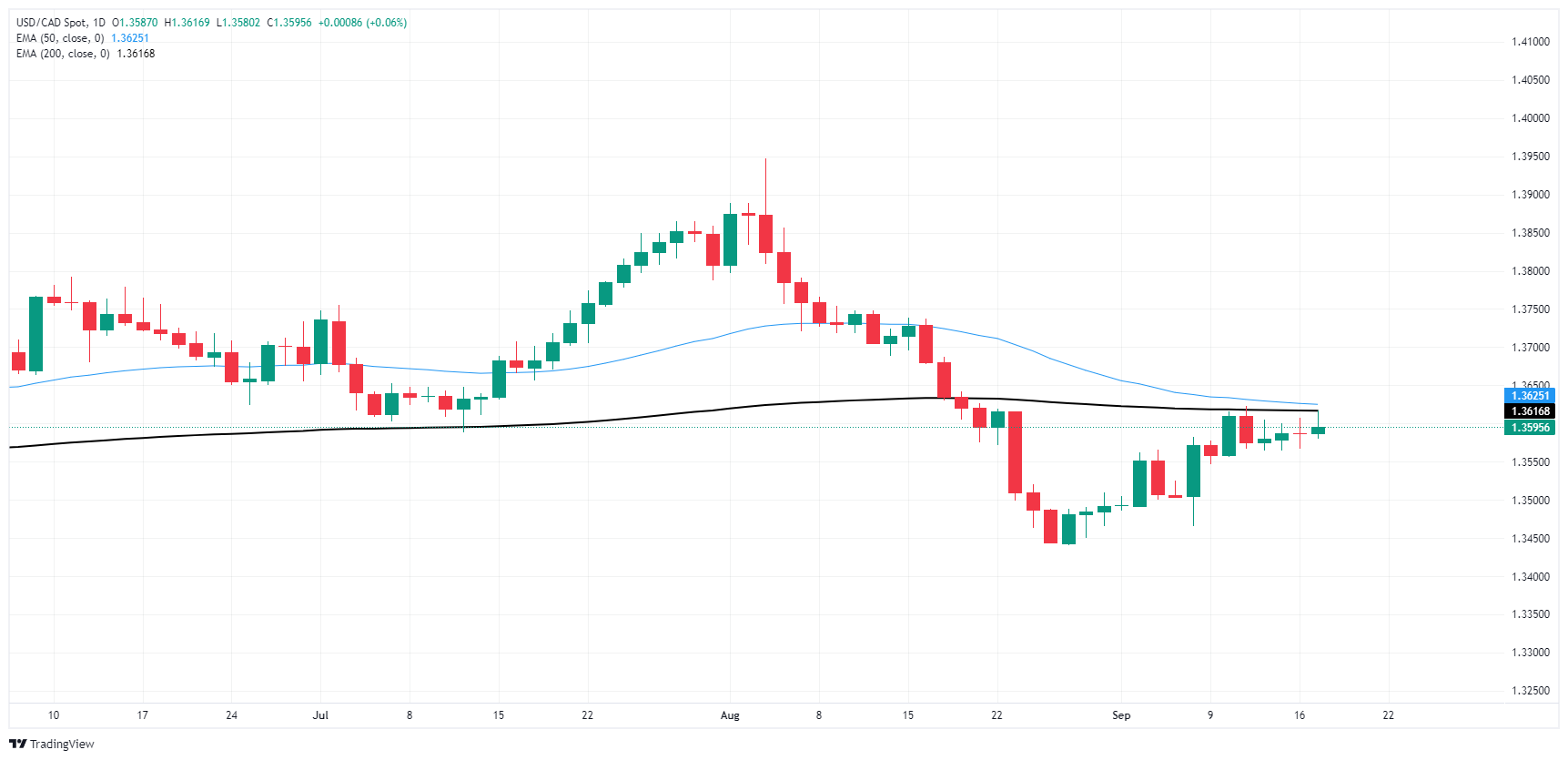- The Canadian dollar remained in familiar territory on Tuesday.
- Canadian CPI inflation data did little to boost confidence in the CAD.
- The Fed’s impending rate decision has markets in wait-and-see mode.
The Canadian Dollar (CAD) settled into familiar mid-range territory on Tuesday after unimpressive Canadian Consumer Price Index (CPI) inflation data failed to generate a bid in CAD flows. The Federal Reserve (Fed) rate decision due on Wednesday looms large over global markets, squashing any unilateral moves in market flows.
Canada released a broadly below-expected set of CPI data, with the headline August CPI figure contracting for the second time in 2024. National year-on-year figures also came in below expectations, with the Bank of Canada’s (BoC) own measure of core CPI inflation cooling further on an annualized basis.
Market drivers
- Canadian CPI figures for August were broadly below expectations on Tuesday, hampering the CAD’s chances of finding momentum before the Fed’s expected rate cut comes to a close during the midweek market session.
- Canada’s headline CPI inflation slowed to 2.0% for the year ending August, below the 2.1% forecast and retreating further from 2.5% previously.
- Canadian monthly CPI inflation contracted by -0.2% in August, missing the forecast of 0.1% and down from the previous month’s 0.4% increase.
- The BoC’s own measure of annualized core inflation was cut to 1.5% from 1.7% previously.
- Global markets are pivoting to face the Fed’s upcoming rate decision on Wednesday, which is universally expected to kick off a new cycle of rate cuts.
- The Fed is expected to cut its main benchmark rate by 25-50 basis points for the first time in more than four years.
Canadian dollar price today
The table below shows the exchange rate of the Canadian Dollar (CAD) against major currencies today. The Canadian Dollar was the strongest currency against the Japanese Yen.
| USD | EUR | GBP | JPY | CAD | AUD | NZD | CHF | |
|---|---|---|---|---|---|---|---|---|
| USD | 0.13% | 0.40% | 1.04% | 0.07% | -0.08% | 0.23% | 0.23% | |
| EUR | -0.13% | 0.28% | 0.90% | -0.10% | -0.21% | 0.10% | 0.10% | |
| GBP | -0.40% | -0.28% | 0.65% | -0.34% | -0.49% | -0.17% | -0.20% | |
| JPY | -1.04% | -0.90% | -0.65% | -0.97% | -1.11% | -0.79% | -0.82% | |
| CAD | -0.07% | 0.10% | 0.34% | 0.97% | -0.14% | 0.19% | 0.14% | |
| AUD | 0.08% | 0.21% | 0.49% | 1.11% | 0.14% | 0.31% | 0.26% | |
| NZD | -0.23% | -0.10% | 0.17% | 0.79% | -0.19% | -0.31% | -0.03% | |
| CHF | -0.23% | -0.10% | 0.20% | 0.82% | -0.14% | -0.26% | 0.03% |
The heatmap shows percentage changes of major currencies. The base currency is selected from the left column, while the quote currency is selected from the top row. For example, if you choose the Canadian Dollar from the left column and move along the horizontal line to the US Dollar, the percentage change shown in the chart will represent the CAD (base)/USD (quote).
Canadian Dollar Price Forecast
The Canadian Dollar (CAD) continues to struggle to find support in the broader currency markets. The CAD is fluctuating in familiar territory against the USD, keeping the USD/CAD hampered just south of the 200-day exponential moving average (EMA) at 1.3617.
1.3600 remains a long-term turning point for USD/CAD. US Dollar bidders have failed to break through the key technical level, but the lack of bullish interest in the CAD has left the Loonie pair spinning in circles.
USD/CAD daily chart
The Canadian Dollar
The key factors determining the Canadian dollar (CAD) are the level of interest rates set by the Bank of Canada (BoC), the price of oil, Canada’s main export, the health of its economy, inflation and the trade balance, which is the difference between the value of Canadian exports and its imports. Other factors include market sentiment, i.e. whether investors are betting on riskier assets (risk-on) or looking for safe assets (risk-off), with risk-on being positive for the CAD. As its largest trading partner, the health of the US economy is also a key factor influencing the Canadian dollar.
The Bank of Canada (BoC) exerts significant influence over the Canadian dollar by setting the level of interest rates that banks can lend to each other. This influences the level of interest rates for everyone. The BoC’s main objective is to keep inflation between 1% and 3% by adjusting interest rates up or down. Relatively high interest rates are generally positive for the CAD. The Bank of Canada can also use quantitative easing and tightening to influence credit conditions, with the former being negative for the CAD and the latter being positive for the CAD.
The price of oil is a key factor influencing the value of the Canadian dollar. Oil is Canada’s largest export, so the price of oil tends to have an immediate impact on the value of the CAD. Generally, if the price of oil rises, the CAD rises as well, as aggregate demand for the currency increases. The opposite occurs if the price of oil falls. Higher oil prices also tend to lead to a higher probability of a positive trade balance, which also supports the CAD.
Although inflation has traditionally always been considered a negative factor for a currency, as it reduces the value of money, the opposite has actually occurred in modern times, with the relaxation of cross-border capital controls. Higher inflation typically leads central banks to raise interest rates, which attracts more capital inflows from global investors looking for a lucrative place to store their money. This increases demand for the local currency, which in Canada’s case is the Canadian dollar.
The released macroeconomic data measures the health of the economy and can have an impact on the Canadian Dollar. Indicators such as GDP, manufacturing and services PMIs, employment and consumer confidence surveys can influence the direction of the CAD. A strong economy is good for the Canadian Dollar. Not only does it attract more foreign investment, but it can encourage the Bank of Canada to raise interest rates, which translates into a stronger currency. However, if the economic data is weak, the CAD is likely to fall.
Source: Fx Street
I am Joshua Winder, a senior-level journalist and editor at World Stock Market. I specialize in covering news related to the stock market and economic trends. With more than 8 years of experience in this field, I have become an expert in financial reporting.







